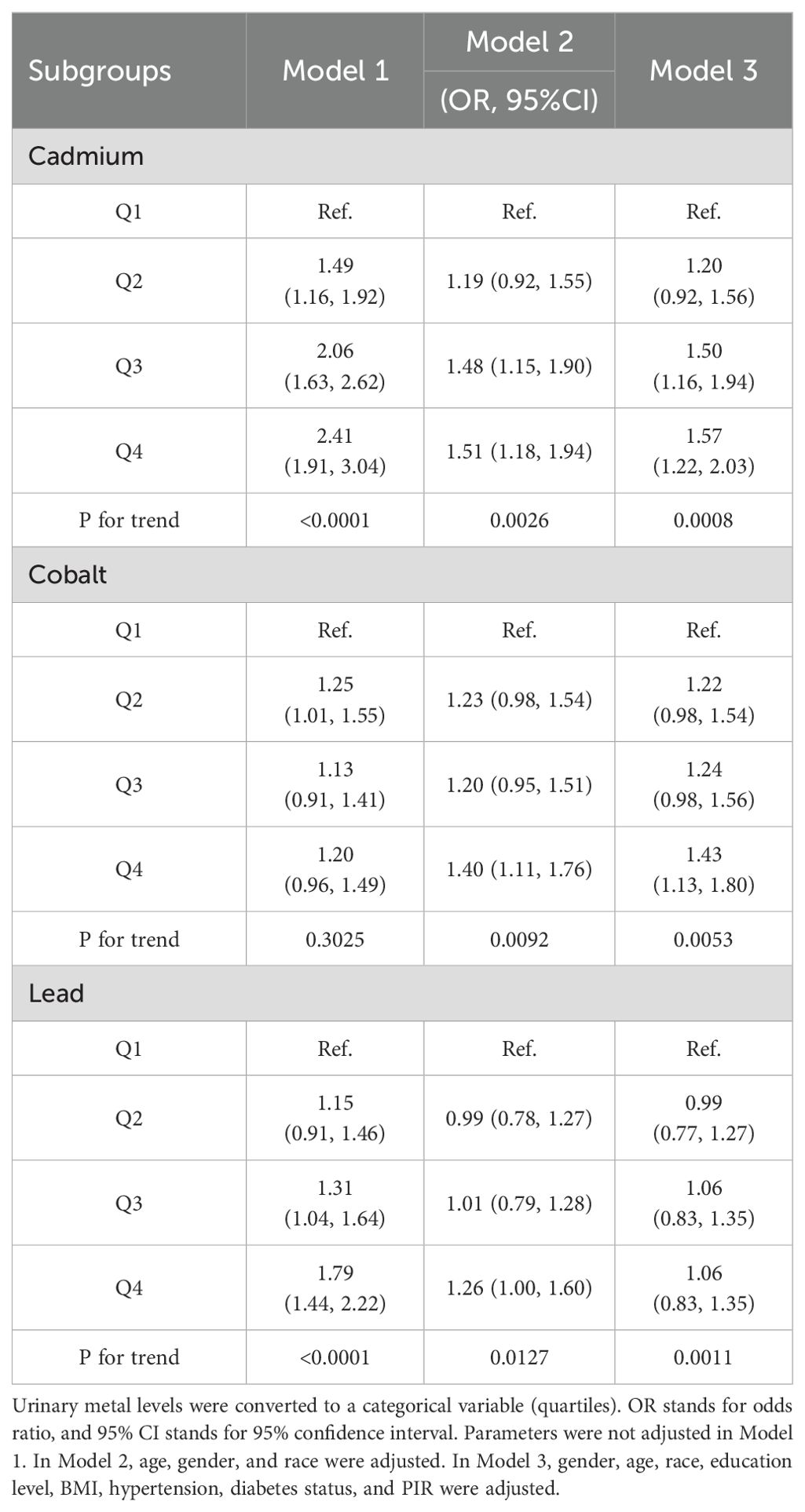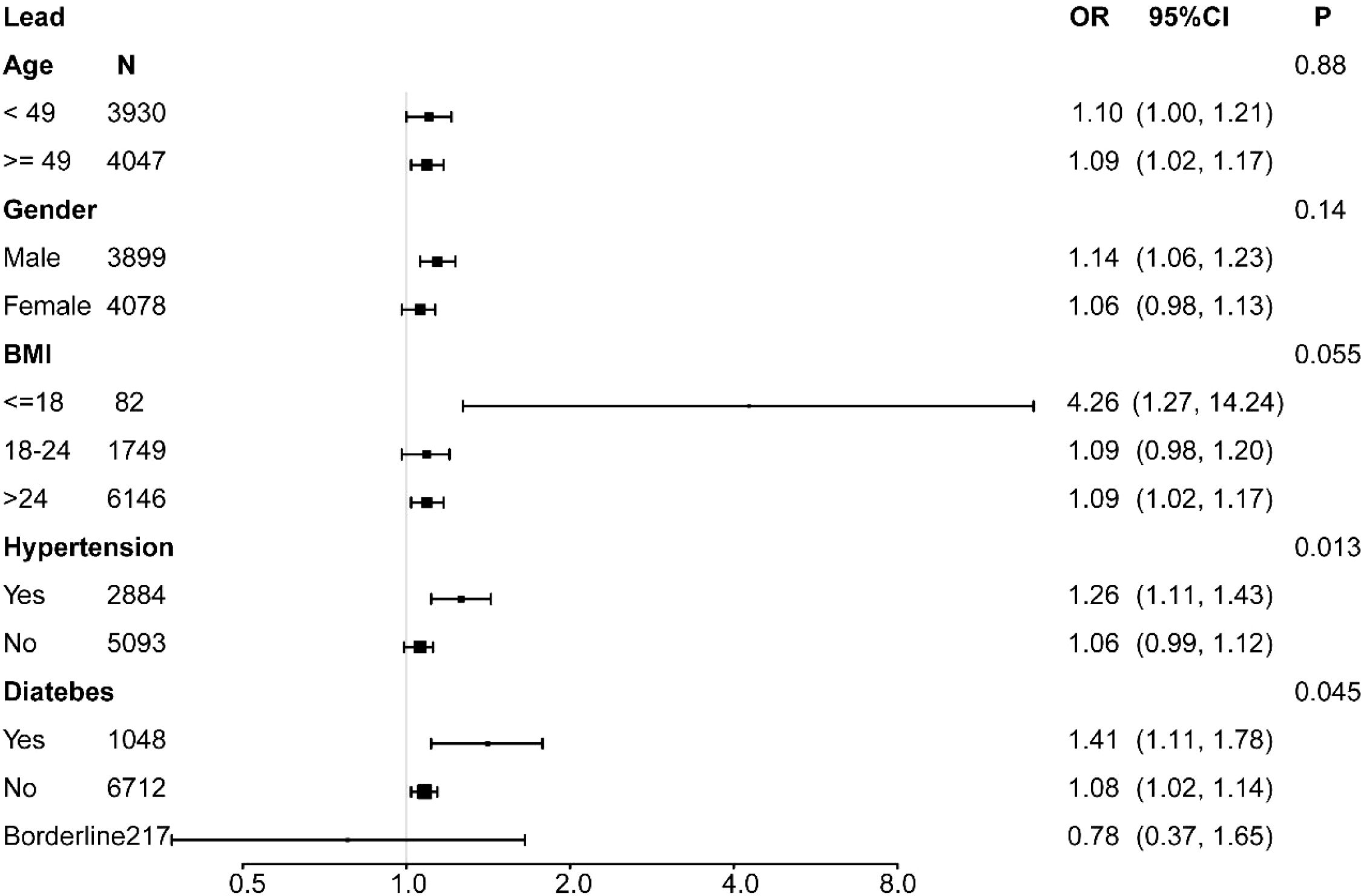- 1Department of Gynecology, Clinical Oncology School of Fujian Medical University, Fujian Cancer Hospital, Fuzhou, Fujian, China
- 2College of Clinical Medicine for Oncology, Fujian Medical University, Fuzhou, Fujian, China
- 3Department of Radiation Oncology, Fudan University Shanghai Cancer Center Xiamen Hospital, Xiamen, China
Aims: The purpose of this study was to evaluate the association between exposure to urinary heavy metals and cancer risk in adults in the United States.
Methods: The statistical data for this study were obtained from the National Health and Nutrition Examination Survey (NHANES) spanning 2009-2018. Participants lacking complete data on urinary heavy metals exposure burden and/or cancer status information were excluded. Urinary heavy metal concentrations were quantified using inductively coupled plasma mass spectrometry (ICP-MS). Cancer diagnoses were ascertained through self-reported medical histories. Multivariable-adjusted regression analyses and cubic smoothing plots were employed to assess independent associations between urinary heavy metal concentrations and cancer risk. Subgroup analyses were performed to assess result robustness.
Results: The study included 7797 participants. Based on the first quartile (Q1), cadmium quartiles showed odds ratios (95% CIs) of 1.20 (0.92, 1.66) 1.50 (1.16, 1.94) and 1.57 (1.22, 2.03) for cancer prevalence (P = 0.0008). Cobalt quartiles were 1.22 (0.98, 1.54), 1.24 (0.98, 1.56), and 1.43 (1.13, 1.80) compared to the first quartile (Q1) (P = 0.0053). In comparison with the first quartile (Q1), Lead quartiles were 0.99 (0.77, 1.27), 1.06 (0.83, 1.35), and 1.06 (0.83, 1.35) (P = 0.0011). In the RCS plot, the association between log2-transformed urinary metal levels and cancer risk was not linear(P<0.05). An analysis of subgroups confirmed the robustness of the results.
Conclusion: Elevated urinary heavy metal concentrations among U.S. adults demonstrated a significant association with increased cancer risk. These findings suggest that mitigating exposure to urinary heavy metals should be prioritized as a preventive strategy for cancer control.
Introduction
According to the Global Cancer Observatory (GLOBOCAN) 2022 estimates, approximately 20 million new cancer cases and 9.7 million cancer-related deaths were documented globally in 2022 (1). It is estimated that one in five men and women will develop cancer at some point in their lives. These statistics underscore the critical need for implementing evidence-based preventive interventions to mitigate the global cancer burden.
Since heavy metals are non-biodegradable, they remain in the body for a longer period of time and pose a long-term health risk. The oxidative stress induced by toxic metals, cell growth stimulation, genomic instability, and alteration of cell proliferation have been well established (2–4).
Cadmium (Cd), cobalt (Co), and lead (Pb) are typical environmental pollutants, and numerous studies have confirmed their association with carcinogenicity. In Korean men, at the current level of exposure, blood lead concentrations were associated with prostate cancer risk (5). Soha et al. found that colon cancer patients had higher levels of Pb and Cu in their blood than healthy people, suggesting that high Pb levels may contribute to colon cancer (6). The serum levels of Cd and Mn were positively related to the risk of nasopharyngeal carcinoma in a study by Soha et al. (7).
In spite of this, previous studies still have some limitations. The majority of previous studies have focused on heavy metal exposure and its link to a single type of cancer (7–9). Then, heavy metal concentrations in the air or blood have been used in most studies to measure the risk of cancer associated with metal exposure (10, 11). Besides, it is unclear how heavy metal exposure affects cancer risk.
In the first part of our study, we analyzed the effect of multiple heavy metals on tumor incidence. Our study measured exposure in a different way by quantifying the concentration of metals in urine, which is the simplest and most non - invasive method available.
In the National Health and Nutrition Examination Survey (NHANES), quantitative methods are used to analyze urine specimens from subjects suspected of being exposed to a number of important metal elements. Accordingly, NHANES (2009–2018) data were used to investigate the association between metal concentrations in adults' urine and cancer.
Materials and methods
Population
In this study, NHANES data were used, an open national survey conducted by the National Center for Health Statistics. Stratified, multistage probability samples of individuals are selected from the general population through a complex statistical process to represent civilian non-institutionalized residents. An interview covers demographic, socioeconomic, dietary, and health-related topics. Its data will be used in epidemiological and health sciences research and can be made public on the NHANES website (https://www.cdc.gov/nchs/nhanes/index.htm). A detailed description of the study design, survey methods, population, and data is available on the website. NHANES data for ten years (2009 - 2010, 2011–2012, 2013–2014, 2015–2016, 2017 - 2018) were aggregated. Among the 25,711 adult participants, 17,734 had no information regarding urinary metal levels or cancer - related outcomes. Finally, 7,977 U.S. adults were enrolled for the analysis of the association between urinary metal concentrations and cancer (Figure 1).
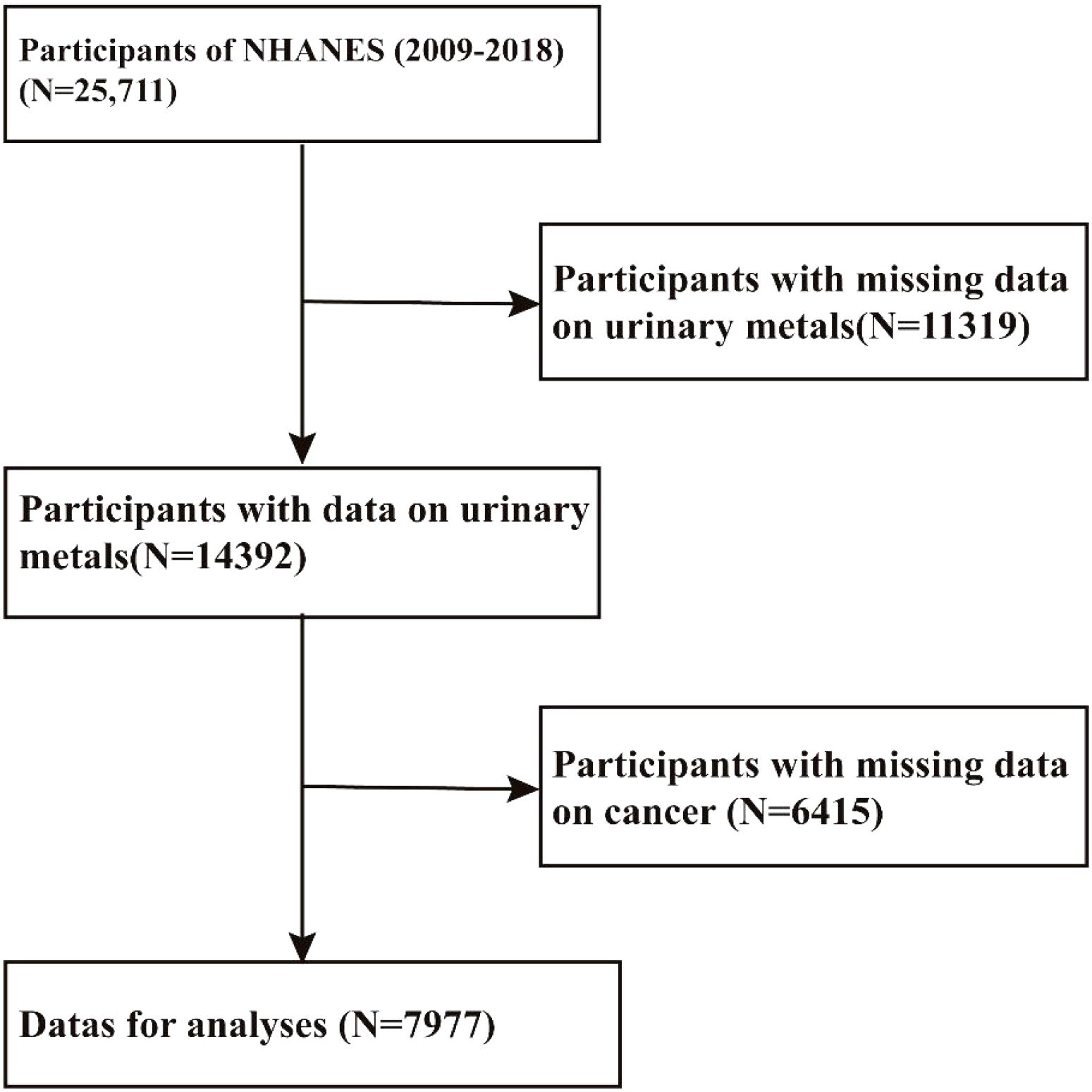
Figure 1. Flow chart of the study population. NHANES: the National Health and Nutrition Examination Survey.
Exposure and outcome definitions
NHANES (2009–2018) urine samples contain metals such as Cadmium, Cobalt, and Lead. After confirming that the collection materials were free from contamination, a casual (or spot) urine specimen was collected from each participant. Inductively coupled plasma mass spectrometry (ICP-MS) was used to detect urinary metal levels. ICP-MS is a multi-element analytical technique capable of analyzing trace levels of elements. A nebulizer reduces liquid samples to small droplets in an argon aerosol and introduces the droplets into the mass spectrometer through the ICP ionization source. In order to determine individual isotopes of an element, the ions pass first through a focusing region, then through the DRC and then the quadrupole mass filter. Upon receipt, urine samples were stored at –30°C until analysis. A detailed procedure manual can be found online (CDC, 2018). A history of cancer was determined based on self-reported physician diagnosis (yes/no).
Covariates
Medical professionals administered uniform interviews, physical examinations, and questionnaires to obtain covariates. Covariates in our study included gender (male/female), age (years), race (Mexican American/other Hispanic/non-Hispanic White/non-Hispanic Black/other races), education level (less than high school/high school or general educational development/above high school), body mass index (BMI), hypertension, diabetes status, and ratio of family income to poverty (PIR). BMI was calculated as weight divided by the square of height (kg/m²). Self-reported histories of hypertension and diabetes mellitus were used to determine the presence of hypertension and diabetes. The detailed measurement processes of the study variables are available at www.cdc.gov/nchs/nhanes/.
Statistical analysis
Categorical variables were presented as percentages, while continuous variables were presented as means with standard errors (SE). An evaluation of the differences in groups divided by cancer was performed using either a weighted Student's t-test or a weighted Chi-square test. The relationship between urinary metals and cancer prevalence was analyzed using multivariate logistic regression models and 95% confidence intervals (CI). The lowest quartile (Q1) of each urinary metal served as the reference group. In Model 1, no covariates were adjusted. Model 2 was adjusted for age, gender, and race. Model 3 was adjusted for gender, age, race, education level, BMI, hypertension, PIR, and diabetes status. To test the heterogeneity of associations between subgroups, an interaction term was added. The heterogeneity of associations across subgroups was assessed using the Likelihood Ratio Test (LRT). The linearity/non-linearity of the relationship between log2-transformed urinary metals and cancer risk was tested using a smooth plot.
P <0.05 was considered statistically significant. Empower software (www.empowerstats.com;X&Y solutions, Inc., Boston MA) and R version 4.1.2 (http://www.R-project.org, The R Foundation) were used for all analyses.
Results
Participants
A total of 7,977 participants were enrolled in the study from the NHANES 2009 to 2018 cycles (Figure 1).
The characteristics of the study population are shown in Table 1. Compared with the non-cancer group, the participants with cancer were older and had a higher prevalence of diabetes and hypertension. The distribution of race and PIR differed between the cancer and non-cancer groups (p < 0.05). No significant difference in gender, education levels, and BMI was observed between the two groups (p > 0.05). The mean cadmium level was 0.35 ± 0.44 µg/l in the non-cancer group and 0.42 ± 0.44 µg/l in the cancer group, respectively. The mean cobalt level was 0.54 ± 1.08 µg/l in the non-cancer group and 0.64 ± 1.50 µg/l in the cancer group. The mean lead level was 0.58 ± 1.08 µg/l in the non-cancer group, while in the cancer group, it was 0.74 ± 1.19 µg/l.
Associations between urinary metals and cancer
Under three models, multivariate logistic regression analysis was used to examine the associations between urinary metals, including cadmium, cobalt, and lead, and cancer risk. In Model 1, no parameters were adjusted. Model 2 adjusted for age, gender, and race. In addition to the variables adjusted for in Model 2, Model 3 further included education level, BMI, hypertension, diabetes status, and PIR (Table 2).
In Model 3, the prevalence of cancer was significantly and positively related to urinary metals (Table 2). Based on the first quartile (Q1), the odds ratios (95% CIs) for cadmium quartiles were 1.20 (0.92, 1.66), 1.50 (1.16, 1.94), and 1.57 (1.22, 2.03) for cancer prevalence (P for trend = 0.0008). Compared with the first quartile (Q1), the odds ratios for cobalt quartiles were 1.22 (0.98, 1.54), 1.24 (0.98, 1.56), and 1.43 (1.13, 1.80) (P = 0.0053). Compared with the first quartile (Q1), the odds ratios for lead quartiles were 0.99 (0.77, 1.27), 1.06 (0.83, 1.35), and 1.06 (0.83, 1.35) (P = 0.0011).
Subgroup analysis
For further evaluation, a subgroup analysis was conducted. Age, gender, BMI, hypertension, and diabetes were included in an interaction test. In the cadmium group, the p-values for interaction did not reach statistical significance, indicating that the association was independent of age, gender, BMI, hypertension, and diabetes (all p > 0.05) (Figure 2). Similar results were observed in the cobalt group (all p > 0.05) (Figure 3). However, urinary lead interactions were significantly associated with hypertension and diabetes (P < 0.05) (Figure 4). Increased urinary lead levels were positively associated with cancer in individuals with hypertension and diabetes (OR = 1.26 and OR = 1.41, respectively).
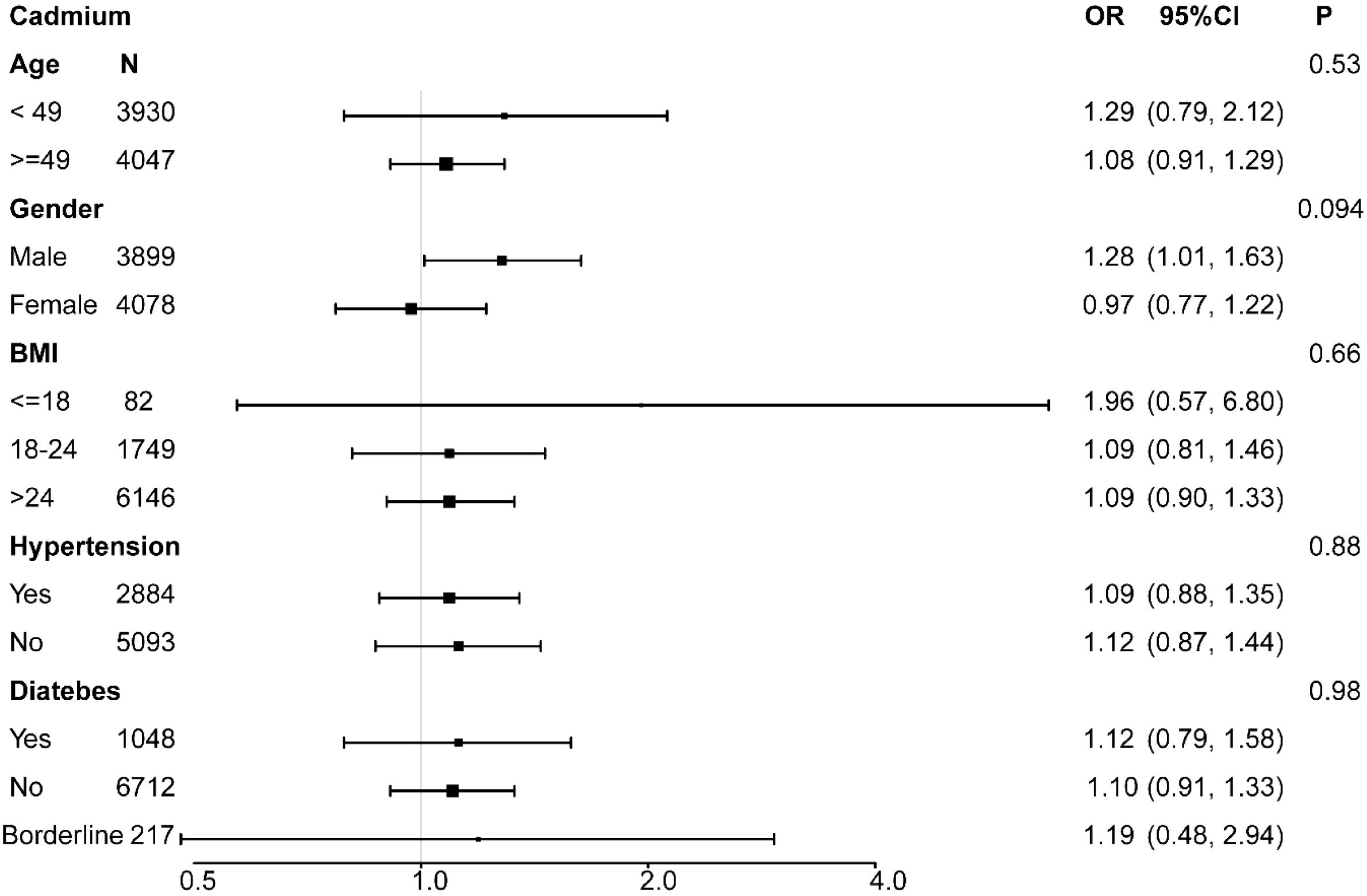
Figure 2. Subgroup analysis for the association between urinary cadmium concentration and cancer risk.
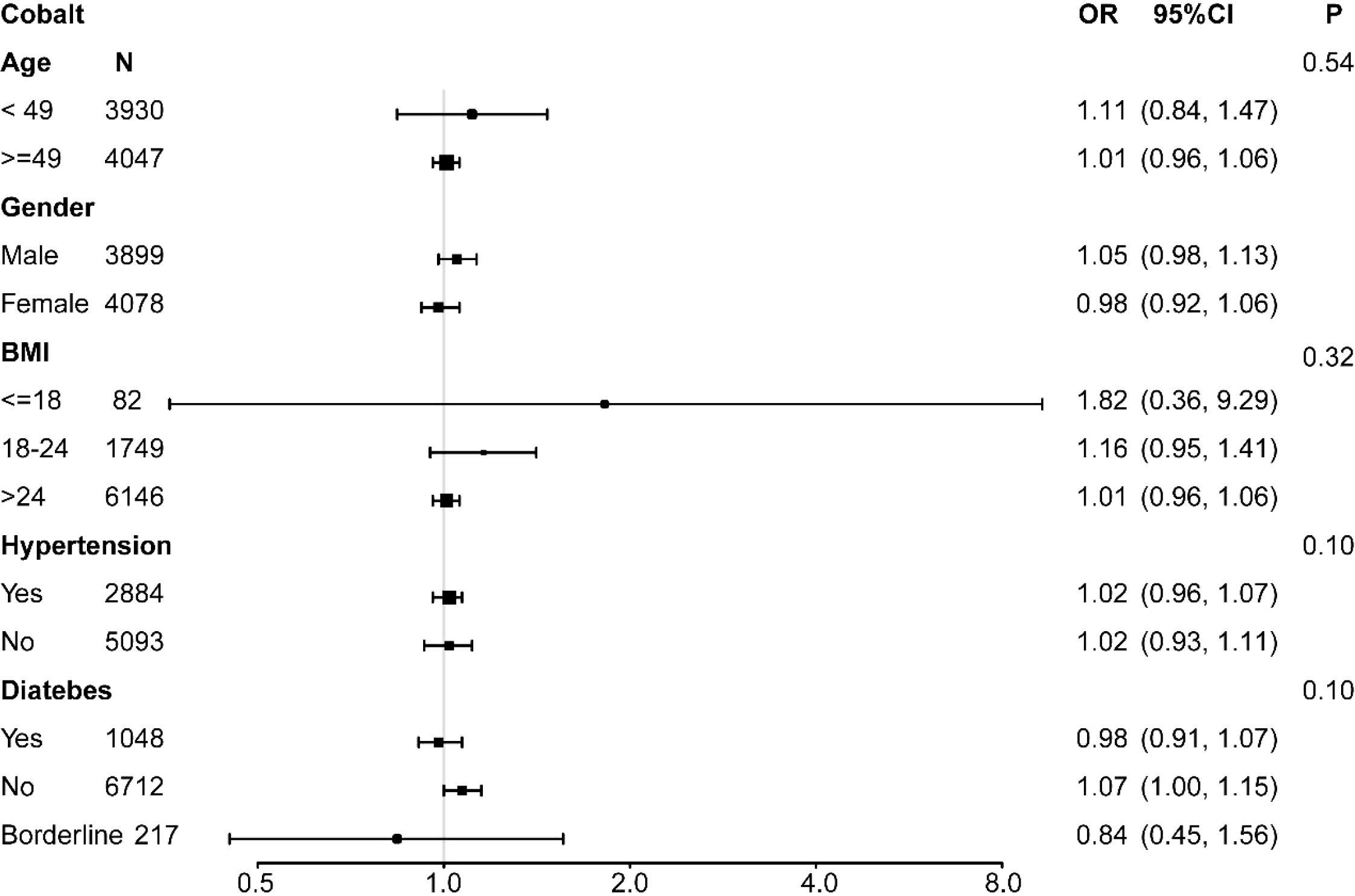
Figure 3. Subgroup analysis for the association between urinary cobalt concentration and cancer risk.
The threshold between urine metals and cancer risk
We used smoothed plots to visualize the relation between urinary metals and the risk of cancer (Figure 5). A significant inverted U-shaped curve was observed between urinary cadmium concentration and tumor risk (P for non-linearity <0.001). The risk of cancer increased with urinary cadmium levels up to the turning point (log2-cadmium = −0.05, corresponding to cadmium = 0.97 µg/l). Here, “log2-cadmium” represents the logarithm of cadmium concentration to the base 2. However, after the turning point, the prevalence of cancer decreased as urinary cadmium levels increased. Likewise, there was a nonlinear association between log2-transformed urinary cobalt and the prevalence of cancer (P = 0.004). The risk of cancer remained relatively stable below 0.97 µg/l (log2-lead = −0.01) of urinary lead, after which it started to increase rapidly (P for non-linearity <0.0001).
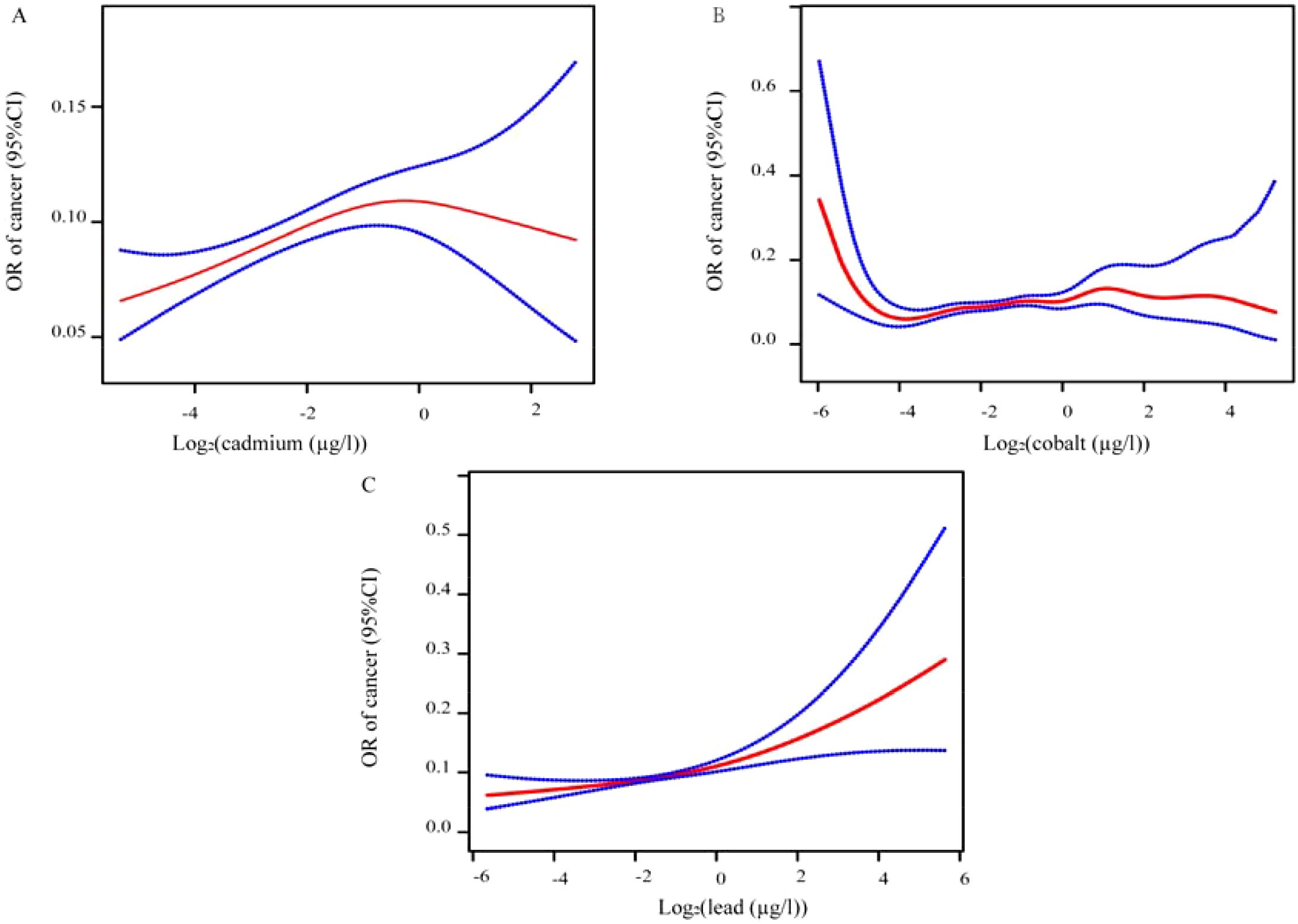
Figure 5. Log2-transformed urinary metal levels and cancer risk were plotted using restricted cubic spline (RCS). RCS regression was adjusted for gender, age, race, education level, BMI, hypertension, diabetes status, and PIR (Model 3). The red and blue lines represent the odds ratios and 95% confidence intervals. Specifically, (A) shows the relationship between log2-transformed cadmium and cancer risk; (B) shows the relationship between log2-transformed cobalt and cancer risk; (C) shows the relationship between log2-transformed lead and cancer risk.
Log2-transformed urinary metal levels and cancer risk were plotted using restricted cubic spline (RCS). RCS regression was adjusted for gender, age, race, education level, BMI, hypertension, diabetes status, and PIR (Model 3). The red and blue lines represent the odds ratios and 95% confidence intervals. Specifically, (A) shows the relationship between log2-transformed cadmium and cancer risk; (B) shows the relationship between log2-transformed cobalt and cancer risk; (C) shows the relationship between log2-transformed lead and cancer risk.
Discussion
In this study, we observed that participants with higher urinary metals levels exhibited an increased risk of cancer. A sensitivity analysis confirmed the robustness of the results. The association was roughly similar in different populations with respect to gender, age, BMI, hypertension, and diabetes status. In addition, the association between urinary metals levels and the risk of cancer was nonlinear. Specifically, the cancer prevalence increased rapidly when urinary lead concentrations exceeded 0.97 µg/l. There was a need to consider urinary metal exposure in clinical settings when assessing people with cancer.
It is the first study to examine the relationship between multiple urinary heavy metal burdens and cancer risk. Several studies have found that metal exposure increases cancer risk (12–16). Zhang et al. reported that an increased risk of lung cancer was associated with higher blood Mo concentration (17). In a previous study, it was found that every doubling of Pb levels increased the odds of prostate cancer by 2.04-fold (5). In previous studies, increased blood cadmium concentration has been implicated in endometrial cancer research (18, 19). All of the above studies have shown that there is a significant association between metals exposure and an elevated risk of cancer among individuals. We found similar results in our study.
As a result of disrupting cellular homeostasis, inducing oxidative stress, and causing DNA damage, metals may contribute to the development of cancer (20, 21). Further, they may alter key signaling pathways that are involved in cell proliferation, epithelial-mesenchymal transitions (22, 23).A primary mechanism of lead (Pb) toxicity is oxidative stress. Pb triggers the production of reactive oxygen species (ROS) inside cells, overwhelming antioxidant defenses and causing oxidative damage to lipids, proteins, and DNA. This cascade results in cellular dysfunction, apoptosis, and ultimately, tissue damage. Cadmium (Cd) primarily elevates reactive oxygen species (ROS) production by inhibiting antioxidant enzymes like superoxide dismutase (SOD) and depleting glutathione (GSH). Consequently, the fundamental mechanism of Cd toxicity lies in the resulting imbalance between heightened oxidative stress and diminished detoxification capacity (6).
Overall, we found that urinary cadmium concentrations and cancer risk are positively correlated. Even though only 1–5% of ingested cadmium was absorbed by the body, its biological half-life was extremely long (24–26). Unbalanced detoxification and increased oxidative stress are the primary mechanisms of cadmium toxicity (27–29). Furthermore, cadmium falls into the category of endocrine disruptor chemicals, which mimic or block endogenous hormone activity (30). Cadmium can interfere with hormones, blocking their interactions with natural counterparts like estrogens and androgens, thus leading to improper hormone signaling (31, 32). Among common heavy metal pollutants, urine cadmium is unique in that it provides information about the total body burden of cadmium over a lifetime (33). The exact range of urinary cadmium that is considered safe has not yet been determined. A urinary cadmium level below 1.0 µg/g is associated with an increased risk of breast cancer, according to previous studies (34). According to our study, the risk of cancer increased with an increase in urinary cadmium concentration below 0.97 µg/l, but decreased with an increase above 0.97 µg/l. Our results may differ slightly from these results for the following reasons. Although urine cadmium levels closely parallel cadmium body burden until 50–60 years of age, recent exposures may also be reflected in urine cadmium among older general populations (35). Due to variable urinary dilution effects throughout the day, spot urine samples may limit the accuracy of exposure assessments (36).
In our study, when urine lead concentrations exceeded 0.97 µg/l, we observed a rapid increase in cancer prevalence. Similarly, a cohort of 20,700 Finnish lead - exposed workers demonstrated that high blood lead levels increased the overall cancer incidence and lung cancer incidence by 1.4 - and 1.8 - fold, respectively (37). The results of one study indicated a 6.60 - fold increase in cancer - specific mortality for individuals with high urinary lead levels when compared to those with low urinary lead levels (38). Our results are generally consistent with previous studies. Reactive oxygen species (ROS) are generated in cells by lead, which overwhelms the body's antioxidant defenses, resulting in oxidative damage to lipids, proteins, and DNA (2, 39–41). According to the nonlinear effects of urinary lead on cancer risk observed in our study, a urinary lead level lower than 0.97 µg/l may be considered relatively safe.
There are several strengths in our research. Firstly, NHANES data, obtained according to a standard procedure, served as the basis for our study. To ensure reliability, we adjusted for confounding factors, which were primarily selected based on previous studies assessing the relationship between cancer and other exposure variables. Additionally, in our study, urinary metals were used as the most non-invasive method for estimating metal concentrations in the body. Moreover, urinary metal concentration has been used as a biomarker for a wide range of physiological and pathological conditions, such as thyroid and renal dysfunctions, cardiac disease, etc (42–44).
However, the present study has several limitations that need to be addressed. The NHANES study used casual (spot) urine samples for the detection of urinary metal concentrations, without considering the effects of metal exposure over time. A second concern is that although confounders were adjusted, possible confounders, such as metals in excipients, may have remained unaccounted for. Due to its cross-sectional design, NHANES cannot establish a causal relationship between urinary metals and cancer. Therefore, it is necessary to confirm this association in future prospective studies.
Conclusion
Increased urinary levels of metals such as cadmium, cobalt, and lead in the United States were associated with an elevated cancer risk, indicating that exposure to urinary metals has an adverse effect on cancer risk. We need to conduct further research to validate our results.
Data availability statement
The raw data supporting the conclusions of this article will be made available by the authors, without undue reservation.
Ethics statement
The studies involving human participants were reviewed and approved by the NCHS Ethic Review Board. The patients/participants provided their written informed consent to participate in this study. The studies were conducted in accordance with the local legislation and institutional requirements. The human samples used in this study were acquired from gifted from another research group. Written informed consent for participation was not required from the participants or the participants’ legal guardians/next of kin in accordance with the national legislation and institutional requirements.
Author contributions
HK: Conceptualization, Formal Analysis, Methodology, Writing – original draft. NX: Data curation, Methodology, Writing – original draft. QW: Software, Writing – original draft. YY: Software, Writing – original draft. YF: Conceptualization, Writing – review & editing.
Funding
The author(s) declare that financial support was received for the research and/or publication of this article. This study was supported in part by grants from the Clinical Research Center for Precision Treatment of Gynecological Malignancies of Fujian Province (Grant number: 2022Y2015).
Acknowledgments
The authors would like to thank all the team members and participants in the National Health and Nutrition Examination Survey (NHANES) for providing the publicly available data.
Conflict of interest
The authors declare that the research was conducted in the absence of any commercial or financial relationships that could be construed as a potential conflict of interest.
Generative AI statement
The author(s) declare that no Generative AI was used in the creation of this manuscript.
Publisher’s note
All claims expressed in this article are solely those of the authors and do not necessarily represent those of their affiliated organizations, or those of the publisher, the editors and the reviewers. Any product that may be evaluated in this article, or claim that may be made by its manufacturer, is not guaranteed or endorsed by the publisher.
References
1. Bray F, Laversanne M, Sung H, Ferlay J, Siegel RL, Soerjomataram I, et al. Global cancer statistics 2022: GLOBOCAN estimates of incidence and mortality worldwide for 36 cancers in 185 countries. CA Cancer J Clin. (2024) 74:229–63. doi: 10.3322/caac.21834
2. Balali-Mood M, Naseri K, Tahergorabi Z, Khazdair MR, and Sadeghi M. Toxic mechanisms of five heavy metals: mercury, lead, chromium, cadmium, and arsenic. Front Pharmacol. (2021) 12:643972. doi: 10.3389/fphar.2021.643972
3. Koedrith P and Seo YR. Advances in carcinogenic metal toxicity and potential molecular markers. Int J Mol Sci. (2011) 12:9576–95. doi: 10.3390/ijms12129576
4. Liu M, Hong Y, Duan X, Zhou Q, Chen J, Liu S, et al. Unveiling the metal mutation nexus: Exploring the genomic impacts of heavy metal exposure in lung adenocarcinoma and colorectal cancer. J Hazard Mater. (2024) 461:132590. doi: 10.1016/j.jhazmat.2023.132590
5. Nam Y, Park S, Kim E, Lee I, Park YJ, Kim TY, et al. Blood Pb levels are associated with prostate cancer prevalence among general adult males: Linking National Cancer Registry (2002-2017) and KNHANES (2008-2017) databases of Korea. Int J Hyg Environ Health. (2024) 256:114318. doi: 10.1016/j.ijheh.2023.114318
6. Bonfiglio R, Sisto R, Casciardi S, Palumbo V, Scioli MP, Palumbo A, et al. The impact of toxic metal bioaccumulation on colorectal cancer: Unravelling the unexplored connection. Sci Total Environ. (2024) 906:167667. doi: 10.1016/j.scitotenv.2023.167667
7. Ge XY, Xie SH, Wang H, Ye X, Chen W, Zhou HN, et al. Associations between serum trace elements and the risk of nasopharyngeal carcinoma: a multi-center case-control study in Guangdong Province, southern China. Front Nutr. (2023) 10:1142861. doi: 10.3389/fnut.2023.1142861
8. Wang M and Yu Q. Association between blood heavy metal concentrations and skin cancer in the National Health and Nutrition Examination Survey, 2011-2018. Environ Sci Pollut Res Int. (2023) 30:108681–93. doi: 10.1007/s11356-023-29674-4
9. Nagata C, Nagao Y, Nakamura K, Wada K, Tamai Y, Tsuji M, et al. Cadmium exposure and the risk of breast cancer in Japanese women. Breast Cancer Res Treat. (2013) 138:235–9. doi: 10.1007/s10549-013-2414-4
10. Kriegel AM, Soliman AS, Zhang Q, El-Ghawalby N, Ezzat F, Soultan A, et al. Serum cadmium levels in pancreatic cancer patients from the East Nile Delta region of Egypt. Environ Health Perspect. (2006) 114:113–9. doi: 10.1289/ehp.8035
11. Lequy E, Leblond S, Siemiatycki J, Meyer C, Vienneau D, de Hoogh K, et al. Long-term exposure to airborne metals and risk of cancer in the French cohort Gazel. Environ Int. (2023) 177:107999. doi: 10.1016/j.envint.2023.107999
12. Rahman HH, Toohey W, and Munson-McGee SH. Exposure to arsenic, polycyclic aromatic hydrocarbons, metals, and association with skin cancers in the US adults. Environ Sci Pollut Res Int. (2023) 30:101681–708. doi: 10.1007/s11356-023-29422-8
13. Lim JT, Tan YQ, Valeri L, Lee J, Geok PP, Chia SE, et al. Association between serum heavy metals and prostate cancer risk - A multiple metal analysis. Environ Int. (2019) 132:105109. doi: 10.1016/j.envint.2019.105109
14. Gianì F, Masto R, Trovato MA, Malandrino P, Russo M, Pellegriti G, et al. Heavy metals in the environment and thyroid cancer. Cancers (Basel). (2021) 13(16):4052. doi: 10.3390/cancers13164052
15. Liu L, Chen J, Liu C, Luo Y, Chen J, Fu Y, et al. Relationships between biological heavy metals and breast cancer: A systematic review and meta-analysis. Front Nutr. (2022) 9:838762. doi: 10.3389/fnut.2022.838762
16. Bell BC, Zhu J, and Wei Y. Urinary concentrations of endocrine-disrupting metals and prevalent breast cancer in US women. Biol Trace Elem Res. (2023) 201:4230–7. doi: 10.1007/s12011-022-03512-z
17. Zhang K, Zhu T, Quan X, Qian Y, Liu Y, Zhang J, et al. Association between blood heavy metals and lung cancer risk: A case-control study in China. Chemosphere. (2023) 343:140200. doi: 10.1016/j.chemosphere.2023.140200
18. Michalczyk K, Kupnicka P, Witczak G, Tousty P, Bosiacki M, Kurzawski M, et al. Assessment of cadmium (Cd) and lead (Pb) blood concentration on the risk of endometrial cancer. Biology (Basel). (2023) 12(5):717. doi: 10.3390/biology12050717
19. McElroy JA, Kruse RL, Guthrie J, Gangnon RE, and Robertson JD. Cadmium exposure and endometrial cancer risk: A large midwestern U.S. population-based case-control study. PLoS One. (2017) 12:e0179360. doi: 10.1371/journal.pone.0179360
20. Gatti V, Fierro C, Annicchiarico-Petruzzelli M, Melino G, and Peschiaroli A. ΔNp63 in squamous cell carcinoma: defining the oncogenic routes affecting epigenetic landscape and tumour microenvironment. Mol Oncol. (2019) 13:981–1001. doi: 10.1002/1878-0261.12473
21. Panatta E, Zampieri C, Melino G, and Amelio I. Understanding p53 tumour suppressor network. Biol Direct. (2021) 16:14. doi: 10.1186/s13062-021-00298-3
22. Bonfiglio R, Granaglia A, Giocondo R, Scimeca M, and Bonanno E. Molecular aspects and prognostic significance of microcalcifications in human pathology: A narrative review. Int J Mol Sci. (2020) 22(1):120. doi: 10.3390/ijms22010120
23. Ganini C, Montanaro M, Scimeca M, Palmieri G, Anemona L, Concetti L, et al. No time to die: how kidney cancer evades cell death. Int J Mol Sci. (2022) 23(11):6198. doi: 10.3390/ijms23116198
24. Fransson MN, Barregard L, Sallsten G, Akerstrom M, and Johanson G. Physiologically-based toxicokinetic model for cadmium using Markov-chain Monte Carlo analysis of concentrations in blood, urine, and kidney cortex from living kidney donors. Toxicol Sci. (2014) 141:365–76. doi: 10.1093/toxsci/kfu129
25. Nawrot T, Plusquin M, Hogervorst J, Roels HA, Celis H, Thijs L, et al. Environmental exposure to cadmium and risk of cancer: a prospective population-based study. Lancet Oncol. (2006) 7:119–26. doi: 10.1016/S1470-2045(06)70545-9
26. Amzal B, Julin B, Vahter M, Wolk A, Johanson G, and Akesson A. Population toxicokinetic modeling of cadmium for health risk assessment. Environ Health Perspect. (2009) 117:1293–301. doi: 10.1289/ehp.0800317
27. Matović V, Buha A, Bulat Z, and Dukić-Ćosić D. Cadmium toxicity revisited: focus on oxidative stress induction and interactions with zinc and magnesium. Arh Hig Rada Toksikol. (2011) 62:65–76. doi: 10.2478/10004-1254-62-2011-2075
28. Sabolić I, Breljak D, Skarica M, and Herak-Kramberger CM. Role of metallothionein in cadmium traffic and toxicity in kidneys and other mammalian organs. Biometals. (2010) 23:897–926. doi: 10.1007/s10534-010-9351-z
29. Lee WK and Thévenod F. Cell organelles as targets of mammalian cadmium toxicity. Arch Toxicol. (2020) 94:1017–49. doi: 10.1007/s00204-020-02692-8
30. Bimonte VM, Besharat ZM, Antonioni A, Cella V, Lenzi A, Ferretti E, et al. The endocrine disruptor cadmium: a new player in the pathophysiology of metabolic diseases. J Endocrinol Invest. (2021) 44:1363–77. doi: 10.1007/s40618-021-01502-x
31. Brama M, Gnessi L, Basciani S, Cerulli N, Politi L, Spera G, et al. Cadmium induces mitogenic signaling in breast cancer cell by an ERalpha-dependent mechanism. Mol Cell Endocrinol. (2007) 264:102–8. doi: 10.1016/j.mce.2006.10.013
32. Gore AC, Chappell VA, Fenton SE, Flaws JA, Nadal A, Prins GS, et al. EDC-2: the endocrine society's second scientific statement on endocrine-disrupting chemicals. Endocr Rev. (2015) 36:E1–e150. doi: 10.1210/er.2015-1010
33. Gammon MD, Santella RM, Neugut AI, Eng SM, Teitelbaum SL, Paykin A, et al. Environmental toxins and breast cancer on Long Island. I. Polycyclic aromatic hydrocarbon DNA adducts. Cancer Epidemiol Biomarkers Prev. (2002) 11:677–85.
34. McElroy JA, Shafer MM, Trentham-Dietz A, Hampton JM, and Newcomb PA. Cadmium exposure and breast cancer risk. J Natl Cancer Inst. (2006) 98:869–73. doi: 10.1093/jnci/djj233
35. Lauwerys RR, Bernard AM, Roels HA, and Buchet JP. Cadmium: exposure markers as predictors of nephrotoxic effects. Clin Chem. (1994) 40:1391–4. doi: 10.1093/clinchem/40.7.1391
36. Berlin A, Alessio L, Sesana G, Dell'Orto A, and Ghezzi I. Problems concerning the usefulness of adjustment of urinary cadmium for creatinine and specific gravity. Int Arch Occup Environ Health. (1985) 55:107–11. doi: 10.1007/BF00378372
37. Anttila A, Heikkilä P, Pukkala E, Nykyri E, Kauppinen T, Hernberg S, et al. Excess lung cancer among workers exposed to lead. Scand J Work Environ Health. (1995) 21:460–9. doi: 10.5271/sjweh.62
38. O'Brien KM, White AJ, Jackson BP, Karagas MR, Sandler DP, and Weinberg CR. Toenail-based metal concentrations and young-onset breast cancer. Am J Epidemiol. (2019) 188:646–55. doi: 10.1093/aje/kwy283
39. Lee JW, Choi H, Hwang UK, Kang JC, Kang YJ, Kim KI, et al. Toxic effects of lead exposure on bioaccumulation, oxidative stress, neurotoxicity, and immune responses in fish: A review. Environ Toxicol Pharmacol. (2019) 68:101–8. doi: 10.1016/j.etap.2019.03.010
40. Yin Y, Zhang P, Yue X, Du X, Li W, Yin Y, et al. Effect of sub-chronic exposure to lead (Pb) and Bacillus subtilis on Carassius auratus gibelio: Bioaccumulation, antioxidant responses and immune responses. Ecotoxicol Environ Saf. (2018) 161:755–62. doi: 10.1016/j.ecoenv.2018.06.056
41. Kasten-Jolly J and Lawrence DA. Sex-specific effects of developmental lead exposure on the immune-neuroendocrine network. Toxicol Appl Pharmacol. (2017) 334:142–57. doi: 10.1016/j.taap.2017.09.009
42. Yorita Christensen KL. Metals in blood and urine, and thyroid function among adults in the United States 2007-2008. Int J Hyg Environ Health. (2013) 216:624–32. doi: 10.1016/j.ijheh.2012.08.005
43. Köse AKZKYDBYGOSK. Association between urinary indicators of renal dysfunction and metal concentrations in workers chronically co-exposed to cadmium, zinc and lead. Biomarkers. (2001) 6:351–6. doi: 10.1080/13547500110045761
Keywords: cadmium, cobalt, lead, cancer, NHANES
Citation: Ke H, Xie N, Wu Q, Ye Y and Fang Y (2025) Heavy metal burden in the urine and cancer risk. Front. Oncol. 15:1545118. doi: 10.3389/fonc.2025.1545118
Received: 14 December 2024; Accepted: 27 June 2025;
Published: 23 July 2025.
Edited by:
L. Joseph Su, University of Texas Southwestern Medical Center, United StatesReviewed by:
Leticia Bucio Ortiz, Autonomous Metropolitan University, MexicoShelbie Stahr, University of Arkansas for Medical Sciences, United States
Copyright © 2025 Ke, Xie, Wu, Ye and Fang. This is an open-access article distributed under the terms of the Creative Commons Attribution License (CC BY). The use, distribution or reproduction in other forums is permitted, provided the original author(s) and the copyright owner(s) are credited and that the original publication in this journal is cited, in accordance with accepted academic practice. No use, distribution or reproduction is permitted which does not comply with these terms.
*Correspondence: Yi Fang, ZmFuZ19hcHJpbEAxMjYuY29t
 Hongqian Ke
Hongqian Ke Ning Xie
Ning Xie Qian Wu3
Qian Wu3
